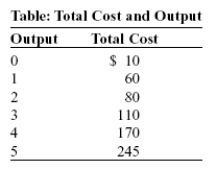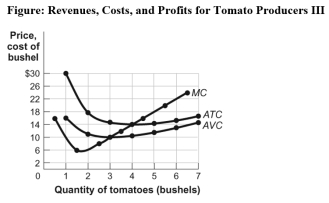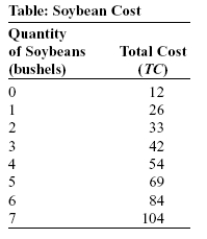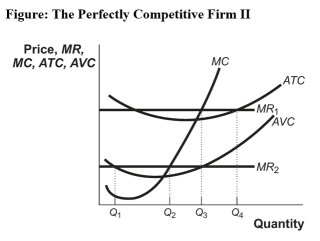A) ATC.
B) MC.
C) MR.
D) AVC.
Correct Answer

verified
Correct Answer
verified
Multiple Choice
Individuals in a market who must take the market price as given are:
A) quantity minimizers.
B) quantity takers.
C) price takers.
D) price searchers.
Correct Answer

verified
Correct Answer
verified
Multiple Choice
Use the following to answer question:  -(Table: Total Cost and Output) Use Table: Total Cost and Output,which describes Sergei's total costs for his perfectly competitive all-natural ice cream firm.What is the minimum price that Sergei needs to receive for a tub of ice cream to stay in business in the long run?
-(Table: Total Cost and Output) Use Table: Total Cost and Output,which describes Sergei's total costs for his perfectly competitive all-natural ice cream firm.What is the minimum price that Sergei needs to receive for a tub of ice cream to stay in business in the long run?
A) $10.00
B) $20.00
C) $33.33
D) $36.67
Correct Answer

verified
Correct Answer
verified
Multiple Choice
When a perfectly competitive industry is in long-run equilibrium,its firms:
A) earn more than zero economic profits.
B) combine their variable and fixed resources inefficiently.
C) are not in short-run equilibrium.
D) allocate all of their resources efficiently.
Correct Answer

verified
Correct Answer
verified
Multiple Choice
In perfect competition,a change in fixed cost will:
A) cause a change in the price in the short run.
B) cause a change in output in the short run.
C) encourage entry or exit in the long run such that price will change enough to leave firms earning zero profits.
D) cause a change in variable cost.
Correct Answer

verified
Correct Answer
verified
Multiple Choice
The addition to the total revenue from selling one more unit of the good is:
A) less than the market price.
B) average profit.
C) marginal cost.
D) marginal revenue.
Correct Answer

verified
Correct Answer
verified
Multiple Choice
If the price is less than the average variable cost at the quantity of output where MR = MC,in the short run a perfectly competitive firm will:
A) produce at a loss.
B) produce at a profit.
C) shut down production.
D) produce more than the profit-maximizing quantity.
Correct Answer

verified
Correct Answer
verified
Multiple Choice
A perfectly competitive firm will produce:
A) whenever it can.
B) mostly in the long run and only if price is greater than AFC.
C) with a loss in the short run if its price is greater than AVC but less than ATC.
D) only when it earns profits in the short run.
Correct Answer

verified
Correct Answer
verified
Multiple Choice
If firms are taking economic losses in the short run,then in the long run,firms will leave the industry,industry output will _____,and economic losses will _____.
A) fall;decrease
B) rise;decrease
C) rise;increase
D) fall;increase
Correct Answer

verified
Correct Answer
verified
Multiple Choice
In the long run,all of the firms in a perfectly competitive industry will:
A) produce at an output level at which average total cost equals marginal cost.
B) earn an economic profit greater than zero.
C) exit the industry if price is greater than average total cost.
D) produce an output level at which price is greater than average total cost.
Correct Answer

verified
Correct Answer
verified
Multiple Choice
Use the following to answer question:  -(Figure: Revenues,Costs,and Profits for Tomato Producers III) Use Figure: Revenues,Costs,and Profits for Tomato Producers III.The market for tomatoes is perfectly competitive.If the market price of a bushel of tomatoes is $12,in the short run this farm will:
-(Figure: Revenues,Costs,and Profits for Tomato Producers III) Use Figure: Revenues,Costs,and Profits for Tomato Producers III.The market for tomatoes is perfectly competitive.If the market price of a bushel of tomatoes is $12,in the short run this farm will:
A) minimize its losses by shutting down.
B) minimize its losses by continuing to produce.
C) break even.
D) earn an economic profit.
Correct Answer

verified
Correct Answer
verified
Multiple Choice
The marginal revenue received by a firm in a perfectly competitive market:
A) is unrelated to the market price.
B) is less than the market price.
C) is greater than the market price.
D) is the change in total revenue divided by the change in output.
Correct Answer

verified
Correct Answer
verified
True/False
Microsoft's Windows operating system is a standardized product,since everyone who buys a particular version of the product gets exactly the same thing.This means that Microsoft is a perfectly competitive firm.
Correct Answer

verified
Correct Answer
verified
Multiple Choice
The equilibrium price of a guidebook is $35 in the perfectly competitive guidebook industry.Our firm produces 10,000 guidebooks for an average total cost of $38,marginal cost of $30,and average variable cost of $30.Our firm,in the short run,should:
A) raise the price of guidebooks because the firm is losing money.
B) keep output the same because the firm is producing at minimum average variable cost.
C) produce more guidebooks because the next guidebook produced will increase profit by $5.
D) shut down because the firm is losing money.
Correct Answer

verified
Correct Answer
verified
Multiple Choice
Use the following to answer question:  -(Table: Soybean Cost) Use Table: Soybean Cost.What is the break-even price for this farmer?
-(Table: Soybean Cost) Use Table: Soybean Cost.What is the break-even price for this farmer?
A) $13.00
B) $13.50
C) $14.00
D) $14.50
Correct Answer

verified
Correct Answer
verified
Multiple Choice
Use the following to answer question:  -(Figure: The Perfectly Competitive Firm II) Use Figure: The Perfectly Competitive Firm II.If this firm's MR curve is MR2,then this firm's optimal output is _____ units of output and its economic profit will be _____.
-(Figure: The Perfectly Competitive Firm II) Use Figure: The Perfectly Competitive Firm II.If this firm's MR curve is MR2,then this firm's optimal output is _____ units of output and its economic profit will be _____.
A) Q1;positive
B) Q2;negative
C) Q3;positive
D) Q4;negative
Correct Answer

verified
Correct Answer
verified
Multiple Choice
In the long run,each firm in a perfectly competitive industry will:
A) earn only enough to cover the opportunity costs of all resources used in production.
B) produce where MR is greater than MC.
C) differentiate its goods.
D) increase its price.
Correct Answer

verified
Correct Answer
verified
Multiple Choice
Suppose that the market for haircuts in a community is perfectly competitive and that the market is initially in long-run equilibrium.Subsequently,an increase in population increases the demand for haircuts.In the short run,the typical firm is likely to:
A) earn an economic profit.
B) incur an economic loss.
C) have no change in its economic profit.
D) have neither an economic profit nor an economic loss.
Correct Answer

verified
Correct Answer
verified
Multiple Choice
A perfectly competitive industry is in a state of long-run equilibrium.Which expression must be TRUE?
A) P = MR = MC > ATC.
B) P = MR = MC < AVC.
C) P = MR = MC = ATC.
D) P > MR = MC = AVC.
Correct Answer

verified
Correct Answer
verified
True/False
The short-run industry supply curve is the sum of the individual supply curves of all of the firms in the industry,given a fixed number of firms.
Correct Answer

verified
Correct Answer
verified
Showing 281 - 300 of 341
Related Exams